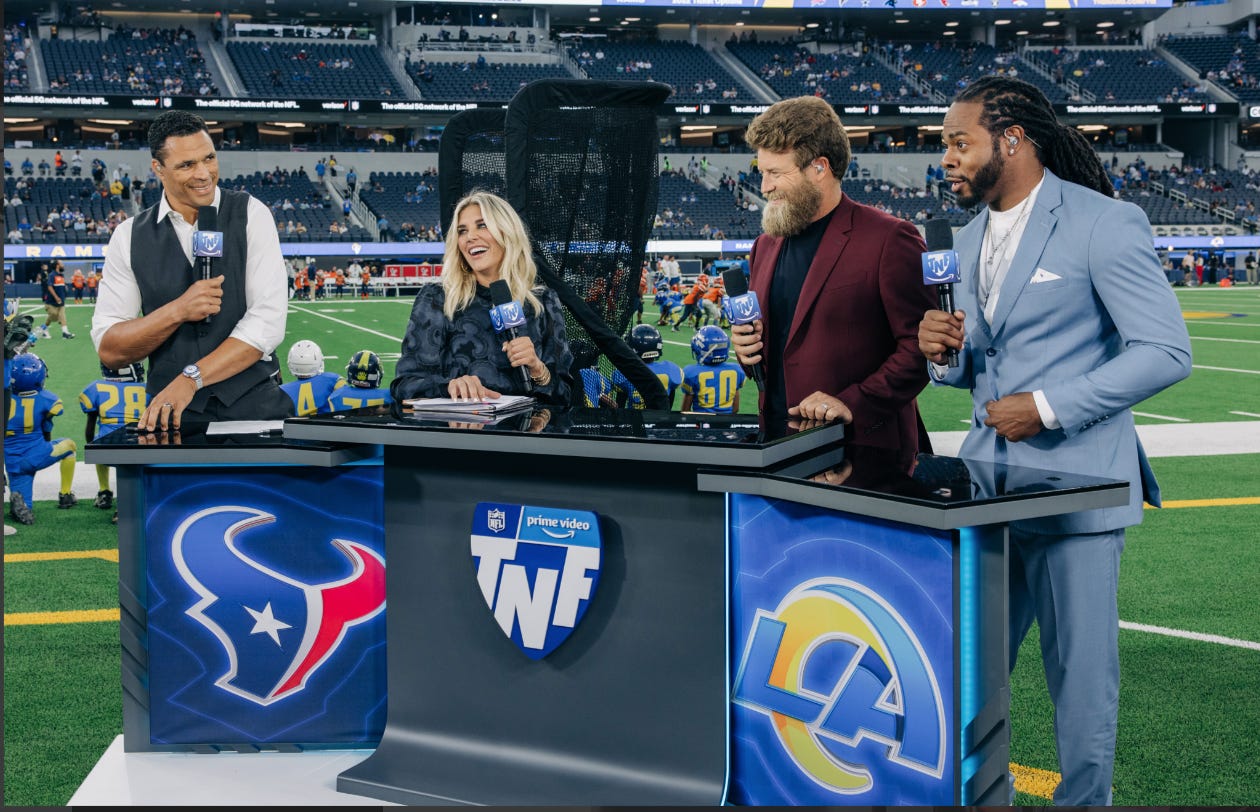Amazon has put the major sports leagues - and the entire cable industry - on notice
Big tech was supposed to provide leverage. They may deliver salvation.
In media circles, there is a longstanding, common narrative - that everything changes once the big tech platforms get serious about sports. I remember having a conversation a few years back with a prominent sales executive, who said “when and if the worlds richest man decides he wants the NFL, all bets are off.”
This was a few years ago - he was right and wrong. The new world’s richest man is focused on decimating Twitter, while the other rich guy he was referring to Jeff Diesel Bezos- did take a bite of the NFL, and maybe really did change everything. But maybe not in the way that we all thought.
Typically, these conversations centered on how big tech may upend the media business, send cord cutting over the edge, or if nothing else, provide huge negotiating leverage for the leagues. All of which is probably true.
But given what’s happens so far a few months into Amazon’s 13-year deal for Thursday Night Football, I wondering if the major US sports leagues need the streaming platforms more than we thought.
Because perhaps the biggest story in media right now isn’t that Amazon’s TNF football ratings have been high, or that the production and delivery of the streaming-only broadcast has gone remarkably well - it’s how young the audience is.
My former colleague Anthony Crupi of Sportico is a sports ratings savant. Look these two tweets, a few months apart, about the NBA Finals and Amazon’s TNF.


Back in May, Crupi wrote about live sports “Gen Z problem” and he’s right. There’s a ticking time bomb that nobody likes to talk about, given how much live sports are propping up the cable model and are the only thing people still like to watch live. It’s the fact that getting young people to sit on a couch for two to three hours and watch a game that they aren’t controlling with a joystick is increasingly challenging, if not going extinct.


That’s why Amazon’s numbers are so noteworthy, and why they should entirely flip sports rights negotiations dynamics over the next decade.
As John Ourand of Sports Business Journal put in on a recent episode of The Town with Matthew Belloni, as Amazon has proven it can bring younger viewers to the NFL, “Every other league commission is a winner. and the losers are the broadcast networks,’ he said.
In previous negotiations with the TV networks, Ourand explained, “It used to be like, ‘yeah, we might to streaming,’ and the networks would laugh and be like ‘good luck have fun.’ Now that is a legitimate outlet for them to go.”
Not just legitimate, but make necessary. Take a look at this data from the analytics firm Antenna.
While Amazon’s NFL deal has been super high profile because of its exclusivity, practically every streaming service sees big subscriber spikes when sports seasons start, from the Premier League to college football to of course, the NFL.
What this says to me is that the fans are there, and they are signing onto streaming services to watch games, even when those games are available on the air. Because many of them just don’t do on the air, or cable, ever.
So I’d argue that the major sports leagues just can’t use streaming platforms to carve out new packages, or to make broadcast networks have to pay more - but they need to move their product to ensure its long term viability.
In other words, if ever want young people to watch your games, you have to go where they live, and not as a side experiment.
As Ourand noted, the NBA TV deal is up in 2025. At this point, how does the league not just consider moving to an Amazon, or a YouTube, but view it as absolutely essential. (Given how global Netflix is, wouldn’t it make so much sense for the NBA especially -but that’s a whole other story).
Plus, read this story from WSJ’s Joe Flint about Warner Discovery’s massive debt problem and tell me how exactly this company is going to afford to make a competitive bid on the NBA anyhow. I’m increasingly wondering if they locked up Charles Barkley just to host a few holiday cookie challenges on the Food Network down the road.
If you’re the NBA, how long is it going to make sense to run your games on zombie basic cable channels, given how much cord-cutting is accelerating?
You might argue, well, what about the advertisers? Don’t they want as many sports on linear TV as possible, so that they can still reach the masses as needed? Yes, which is likely why you’ll see some games remain on broadcast for a long time. But then again, advertisers are racing into CTV, and will soon come to expect more trackable impact from their campaigns as the norm. Already, Amazon is showing that its games are delivering a more responsive audience: through week 8, these viewers are 42% more likely to search for brands advertised during the games than viewers of ads of linear primetime NFL games like Sunday and Monday Night Football.
To be sure, simply moving sports rights to digital platforms won’t fix everything. The leagues are still going to have to try all sorts of things to make prolonged live TV viewing more compelling- whether its using influencers during broadcasts or adding comments or betting or whatever.
Regardless, the rationale from keeping sports deals in traditional TV universe is starting to crack. If and when these leagues go all in on streaming - that’s when the entire cable model may start breaking down.










Thanks so much!
Dynamite article Mike!